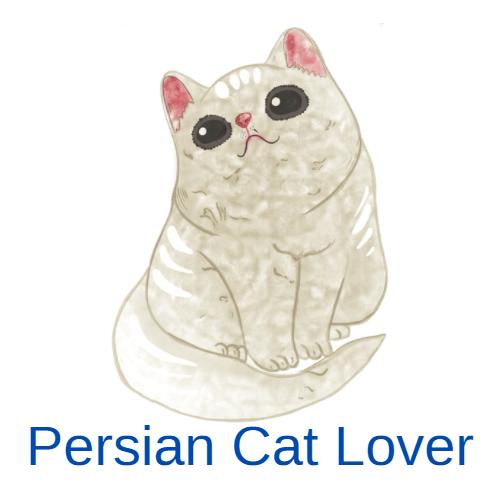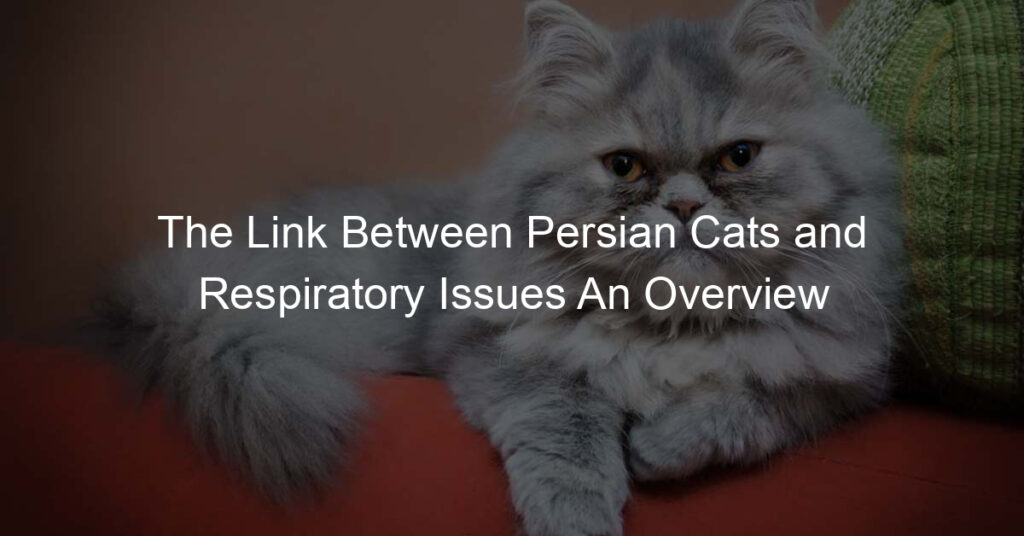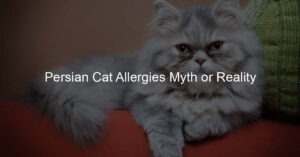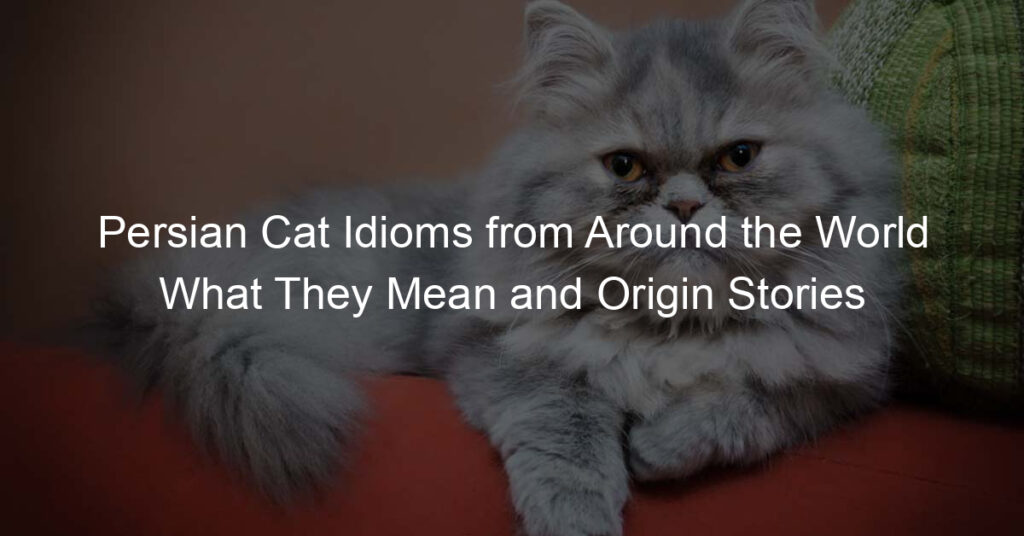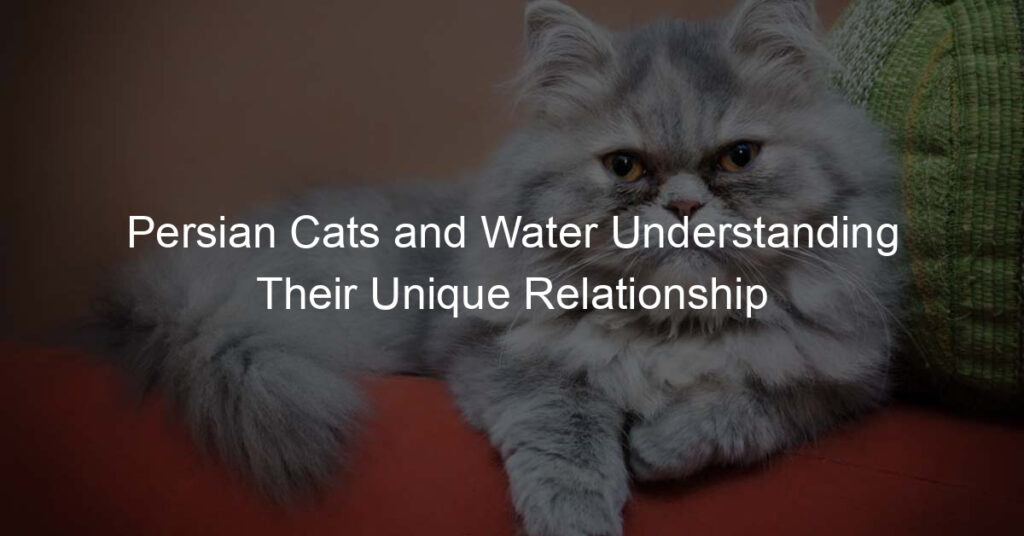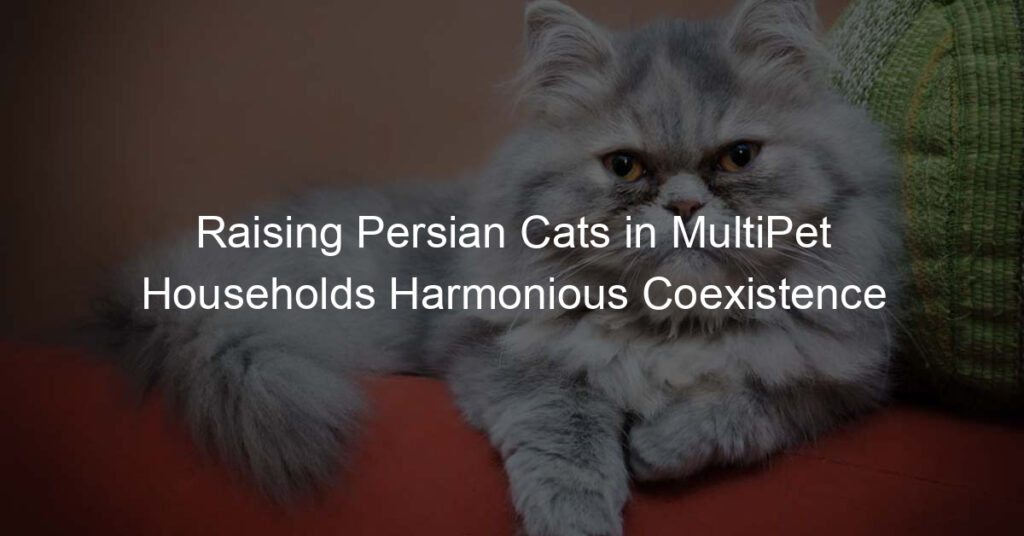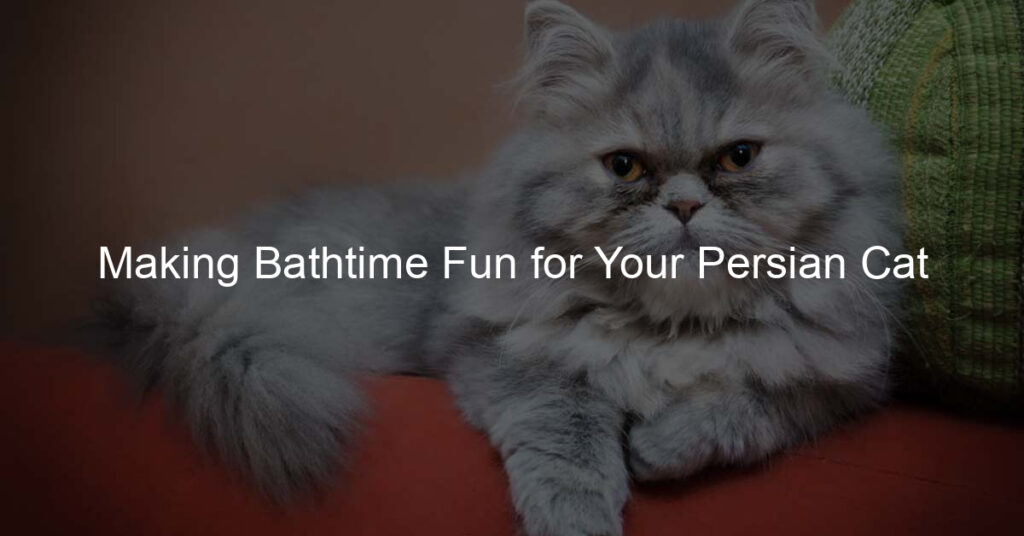Persian cats are known for their unique and luxurious appearance, with their long, silky coats and distinctive facial structure. However, these beautiful felines are also prone to respiratory issues. In this overview, we will explore the link between Persian cats and respiratory problems, discussing the specific breathing issues they may experience and examining the research and studies conducted on this subject.
Persian cats, also known as Longhairs, are one of the most popular cat breeds globally. Their popularity can be attributed to their gentle and affectionate nature, as well as their stunning appearance. However, their distinct facial structure and genetic predisposition make them more susceptible to respiratory problems.
Respiratory issues in Persian cats refer to a range of conditions that affect their airways and breathing. These issues can include conditions such as brachycephalic airway syndrome, upper respiratory infections, and polycystic kidney disease. Persian cats may also exhibit symptoms like wheezing, coughing, nasal discharge, sneezing, and watery eyes.
Several studies have been conducted to explore the link between Persian cats and respiratory issues. Research has shown that Persian cats have a higher prevalence of respiratory problems compared to other cat breeds. These studies have also highlighted the role of genetic factors, such as the presence of certain gene mutations, in the development of these issues.
While genetics play a significant role, other contributing factors to respiratory problems in Persian cats include their short facial structure, which can lead to issues with their airways and breathing. care and grooming practices, such as improper cleaning of tear ducts or lack of regular grooming, can also contribute to respiratory problems.
Recognizing the signs and symptoms of respiratory issues in Persian cats is crucial for early detection and intervention. Common signs include wheezing, coughing, difficulty breathing, nasal discharge, sneezing, watery eyes, reduced appetite, and weight loss. If any of these signs are observed, prompt veterinary attention is recommended.
Prevention and management of respiratory issues in Persian cats involve several strategies. Regular veterinary check-ups and monitoring are essential to catch any issues early on and ensure the overall health of the cat.
Creating an optimal environment with proper ventilation and avoiding environmental irritants is also important. practicing proper grooming techniques, such as regularly cleaning tear stains and keeping their coats free of matting, can help reduce the risk of respiratory problems. Finally, ensuring a balanced diet and proper nutrition can support overall respiratory health.
Key takeaway:
- Persian cats are a popular breed known for their distinct features and long, luxurious fur.
- Persian cats have a higher risk of respiratory issues due to their genetic predisposition and short facial structure.
- Regular veterinary check-ups, optimal environmental conditions, proper grooming techniques, and a balanced diet can help prevent and manage respiratory issues in Persian cats.
Introducing Persian Cats
Introducing Persian Cats
| Persian cats are a popular breed known for their long, luxurious coats. |
| They have a distinctive round face with large, expressive eyes. |
| These cats are known for their calm and gentle temperament. |
| Persian cats require regular grooming to keep their coat in good condition. |
| They are generally indoor cats and prefer a quiet and peaceful environment. |
| Persian cats come in a variety of colors and patterns, including solid, tabby, and bicolor. |
| They are known for their low activity levels and enjoy relaxing and lounging around. |
| Persian cats have a lifespan of around 12-16 years. |
| They are prone to certain health issues, such as respiratory problems, due to their short snouts. |
| Persian cats are loyal companions and form strong bonds with their owners. |
What Are Persian Cats?
Persian cats are a delightful breed known for their unique characteristics and appearance. These cats, commonly referred to as “What Are Persian Cats?“, are characterized by their long, luxurious coats, round faces, and large, expressive eyes. They are medium to large in size and have a sturdy build.
The Persian cat breed originated in Persia, now known as Iran, and was imported to Europe in the 17th century. These cats quickly gained popularity due to their elegant appearance and gentle temperament.
“What Are Persian Cats?” have a calm and gentle nature, making them great companions for families and individuals alike. They are known to be affectionate and enjoy the company of their human counterparts. Persian cats are often described as being laid-back and easygoing.
In terms of care, “What Are Persian Cats?” requires regular grooming to keep their long coats looking their best. The coat needs to be brushed daily to prevent matting and hairballs. Regular vet check-ups are important to ensure their overall health and well-being.
“What Are Persian Cats?” can come in a variety of colors and patterns, including solid, tabby, and bicolor. Their unique appearance and gentle personality make them a favorite choice among cat lovers.
Why Are Persian Cats Popular?
Persian cats are highly sought-after cat breeds worldwide due to several compelling reasons. One of the primary factors contributing to their popularity is their breathtaking beauty. These cats are well-known for their striking appearance, featuring long, luxurious coats, expressive eyes, and sweet, gentle facial features. With an air of elegance and grace, Persian cats captivate the hearts of cat enthusiasts around the globe.
Another key reason for their popularity is their calm and gentle nature. Persian cats are renowned for their docile and sweet personalities. They possess a natural affinity for being calm, friendly, and affectionate, making them the perfect companions for individuals and families alike. Their gentle nature and serenity contribute to their widespread recognition and admiration as family pets.
While Persian cats do enjoy their alone time and value quiet moments, they also form close bonds with their owners, showcasing their independent yet affectionate nature. These cats have a special affinity for their human companions, enjoying petting and cuddling sessions that create profound emotional connections. This loving and affectionate behavior further enhances their appeal and popularity.
Additionally, Persian cats have relatively low exercise requirements, making them suitable for individuals who prefer a more relaxed pet. They possess lower energy levels and find contentment in a calm and tranquil lifestyle. This aspect of their temperament aligns well with people seeking a more laid-back pet, contributing to their desirability.
Persian cats are widely recognized for their admirable temperament. Their easygoing and gentle personality paves the way for harmonious relationships with other pets and children, making them a popular choice for households with multiple animals or families with young kids. Their exceptional compatibility and peaceful nature add to their appeal and favorability.
Aesthetic appeal is another significant factor contributing to the popularity of Persian cats. These felines possess a unique and regal appearance often associated with luxury and sophistication. Their distinctive features, including velvety coats, make them visually captivating. For those with an eye for beauty, Persian cats present an irresistible allure.
Furthermore, the enduring popularity of Persian cats can be attributed to their historical significance and reputation as cherished companions. Throughout centuries, these cats have held a special place in the hearts of cat lovers worldwide. Their rich history and esteemed status as feline companions have only intensified their desirability and elevated their status.
In summary, the popularity of Persian cats stems from their breathtaking beauty, calm and gentle nature, low exercise requirements, compatibility with other pets and children, and their long-standing reputation as esteemed feline companions. These factors collectively contribute to their widespread popularity and make them highly sought-after cat breeds globally.
Persian cats and respiratory issues go together like cat hair and your favorite black sweater – an unfortunate but unavoidable combination.
The Association Between Persian Cats and Respiratory Issues
plaintext
The association between Persian cats and respiratory issues is a well-documented fact. Persian cats are often associated with respiratory issues due to their unique facial structure, characterized by a short nose and a flattened face. These traits can lead to various respiratory problems, including difficulty breathing, snoring, and nasal congestion. It is crucial for potential owners to be aware of these issues before adopting a Persian cat.
Studies have shown that up to 60% of Persian cats experience some form of respiratory problem, highlighting the strong association between Persian cats and respiratory issues. These problems can range from mild to severe, with some cats requiring medical intervention or even surgery to alleviate their symptoms.
One common respiratory issue seen in Persian cats is brachycephalic airway syndrome. This condition narrows the cat’s airways, making it challenging for them to breathe properly. Persian cats are also prone to nasal polyps, infections, and allergies, which further contribute to their respiratory issues.
If you are considering adopting a Persian cat, it is crucial to be prepared for the potential respiratory issues that may arise. Regular veterinary check-ups and proper care are essential to manage these problems and ensure the cat’s well-being. Additionally, maintaining a clean and well-ventilated environment can minimize respiratory irritants.
The association between Persian cats and respiratory issues cannot be ignored. Potential owners must be aware of these problems and take appropriate measures to ensure the cat’s health. Despite their predisposition to respiratory issues, Persian cats can lead happy and healthy lives with proper care and attention.
What Are Respiratory Issues in Persian Cats?
When it comes to Persian cats, respiratory issues can be a common concern. What Are Respiratory Issues in Persian Cats? These issues refer to any problems or difficulties related to breathing that Persian cats experience. It is important for cat owners to be aware of these issues and how to identify them in their pets.
Some specific breathing problems that Persian cats may experience include wheezing and coughing, difficulty breathing and panting, nasal discharge and sneezing, watery eyes, and reduced appetite and weight loss. These symptoms may vary in severity and can be caused by various factors such as genetic predisposition, the cat’s short facial structure, and certain care and grooming practices.
To prevent and manage respiratory issues in Persian cats, regular veterinary check-ups and monitoring are essential. This will help to catch any issues early on and ensure proper treatment.
Creating optimal environmental conditions, such as minimizing exposure to allergens and maintaining good ventilation, can also help improve respiratory health. Using proper grooming techniques, such as regularly cleaning the cat’s face and eyes, can keep the respiratory system clear.
Ensuring a balanced diet and nutrition can strengthen the cat’s overall health and support respiratory function.
By being aware of respiratory issues in Persian cats and taking the necessary steps for prevention and management, cat owners can help their pets maintain optimal respiratory health. If any concerning symptoms are observed, it is always best to consult with a veterinarian for a proper diagnosis and appropriate treatment.
What Are the Specific Breathing Problems Persian Cats May Experience?
Persian cats may experience specific breathing problems due to their unique facial structure. These issues result from the Persian cat’s shortened face, which can lead to various respiratory problems.
One particular breathing problem that Persian cats may encounter is brachycephalic airway syndrome. Narrowed nostrils, an elongated soft palate, and a narrow windpipe characterize this condition. These anatomical abnormalities can cause difficulty breathing, wheezing, and coughing.
Another breathing issue that Persian cats may face is heat intolerance. Due to their flattened faces, Persian cats have compromised airways, making it more challenging for them to regulate their body temperature in hot weather. This can result in extreme panting and shortness of breath.
In addition, Persian cats are prone to developing upper respiratory infections. Their flat faces make them more susceptible to viral and bacterial infections, which can lead to symptoms such as nasal discharge, sneezing, and watery eyes.
To manage these breathing problems, it is crucial to provide optimal environmental conditions for Persian cats. This includes keeping them in a cool and well-ventilated space, especially during hot weather.
Regular veterinary check-ups and monitoring are essential to identify any respiratory issues early on. Proper grooming techniques, like cleaning the nose and eyes, can also help prevent infections.
Understanding the specific breathing problems that Persian cats may experience is vital for their overall well-being. By being aware of these issues, cat owners can take appropriate measures to ensure their Persian cats lead happy and healthy lives.
Persian cats have been known for their distinctive features, including their flat faces and luxurious long coats, for centuries. Originating in Persia (modern-day Iran), these cats were highly favored by royalty and nobility. The unique appearance of Persian cats has captured the hearts of cat enthusiasts worldwide.
Their charming looks come with certain health challenges, particularly regarding their respiratory system. As these cats gained popularity, breeders have been working to address these breathing problems and improve the overall health of Persian cats. Today, responsible breeding practices and increased awareness have helped mitigate the impact of these breathing issues, ensuring that Persian cats can live comfortable lives.
If breathing issues were a contest, Persian cats would be the reigning champions.
Research and Studies on the Link between Persian Cats and Respiratory Issues
Research and studies on the link between Persian cats and respiratory issues have yielded valuable insights into this health problem. Multiple investigations have examined the prevalence and causes of respiratory problems in Persian cats, illuminating the specific risks associated with this particular breed.
One study published in the Journal of Feline Medicine and Surgery discovered that Persian cats have a higher susceptibility to developing respiratory issues compared to other breeds. The study meticulously analyzed data from over 1,000 cats and unveiled that respiratory problems were more prevalent in Persians, with a significant proportion experiencing chronic upper respiratory tract infections.
Another research article, published in the Veterinary Medicine International journal, delved into the genetic predisposition of Persians to respiratory issues. The study identified distinct genetic markers linked to breathing difficulties in this breed, providing invaluable information for breeders and veterinarians.
A study published in the Journal of Small Animal Practice extensively examined the relationship between the short facial structure of Persian cats and their respiratory problems. The research demonstrated that the brachycephalic (short-nosed) facial structure of Persians can contribute to breathing difficulties, including snoring, wheezing, and panting.
These research and studies underscore the significance of comprehending the connection between Persian cats and respiratory issues.
By recognizing the genetic predisposition and the impact of their short facial structure, breeders and owners can employ preventive measures to minimize the risk of respiratory problems. Regular veterinary check-ups, optimal environmental conditions, proper grooming techniques, and a balanced diet are all crucial factors in managing and preventing respiratory issues in Persian cats.
Persian cats: breathing issues fit for a cat-astrophe!
Possible Causes and Contributing Factors
It’s fascinating to dive into the possible causes and contributing factors behind the link between Persian cats and respiratory issues. From genetic predisposition to their unique short facial structure and even their care and grooming practices, each sub-section holds key insights into this intriguing connection. So, let’s explore what these factors reveal about the health and well-being of these captivating felines.
Genetic Predisposition
Persian cats have a genetic predisposition that makes them more prone to respiratory issues compared to other cat breeds. This genetic predisposition means that Persian cats have a higher risk of developing breathing problems and respiratory conditions.
One of the main factors contributing to this genetic predisposition is their facial structure. Persian cats have short and flattened faces, known as brachycephalic, which can lead to respiratory difficulties. This facial structure affects their airways and can result in breathing problems such as snoring, wheezing, and difficulty breathing.
While not all Persian cats will experience respiratory issues, it is important for owners of Persian cats to be aware of this genetic predisposition and take proper precautions. Regular veterinary check-ups and monitoring are essential in detecting any respiratory issues early and managing them effectively.
Creating an optimal environment for Persian cats is also crucial in preventing respiratory problems. This includes providing good ventilation, avoiding exposure to smoke and other irritants, and keeping the environment clean and free from allergens.
Proper grooming techniques are important for Persian cats as well. Regular brushing helps to prevent matting and allows for better airflow around the face. Keeping the face clean and free from excessive tear staining can also help in reducing respiratory issues.
Diet and nutrition play a role in the overall health of Persian cats, including their respiratory health. A balanced diet with appropriate nutrition can help strengthen their immune system and maintain overall well-being.
Understanding the genetic predisposition of Persian cats to respiratory issues allows owners to be proactive in managing their cats’ health. By taking these factors into consideration and providing appropriate care, owners can help minimize the impact of respiratory issues and ensure the well-being of their Persian cats.
Historically, Persian cats originated in Iran (formerly known as Persia) and were beloved by the aristocracy and royalty.
Their luxurious long fur and unique facial features made them highly sought-after pets. Over time, breeders selected certain traits, including the distinctive flat face, which contributed to the breed’s predisposition to respiratory issues.
Despite these challenges, Persian cats remain popular pets today, known for their calm and gentle nature. The genetic predisposition of Persian cats to respiratory issues highlights the importance of responsible breeding practices and diligent care to ensure the health and well-being of these beautiful feline companions.
Short Facial Structure
Short Facial Structure is a common characteristic of Persian cats, which can contribute to respiratory issues in these feline breeds. This facial feature is notable for its flat face, shortened muzzle, and prominent eyes.
| Flat face | Shortened muzzle | Prominent eyes |
The short facial structure of Persian cats can cause certain anatomical changes, which may lead to breathing difficulties. The structure of their nasal passages can be constricted, making it harder for air to flow freely. The flatter face can also affect the position and size of the soft palate, further obstructing the airway.
Due to these anatomical changes, Persian cats are more prone to respiratory issues, such as snoring, wheezing, and difficulty breathing. They may also experience increased susceptibility to respiratory infections and upper respiratory tract diseases.
To manage and minimize respiratory problems in Persian cats with short facial structures, it is essential to provide appropriate care and create an optimal living environment. Regular veterinary check-ups are crucial for early detection and monitoring of respiratory issues. Proper grooming techniques, including cleaning the face and ensuring the nostrils are clear, can help maintain respiratory health.
It is also recommended to provide an environment with optimal humidity levels, as dry air can exacerbate breathing difficulties. Good quality air circulation and avoiding exposure to smoke or strong odors is beneficial. A balanced and nutritious diet can support overall health and boost the immune system, which in turn can help reduce the risk of respiratory problems.
Ensuring the well-being of Persian cats with short facial structures requires attention to their specific needs. With proper care, these adorable feline companions can lead comfortable and healthy lives.
Care and grooming practices: Because even Persian cats need a little extra pampering, but just don’t tell them it’s for their own good.
Care and Grooming Practices
When it comes to caring for and grooming Persian cats, it’s important to follow certain care and grooming practices to ensure their well-being and minimize the risk of respiratory issues. Here are some essential care and grooming practices to keep in mind:
| Regular brushing: Persian cats have long, luxurious coats that require daily brushing as part of their care and grooming routine to prevent matting and tangles. This also helps to remove loose hair and reduce the chances of hairballs. Bathing: While Persian cats don’t require frequent baths, occasional baths can be a part of their care and grooming practices to help keep their coat clean and free from dirt and allergens. Use a gentle cat shampoo and ensure thorough rinsing. Eye care: Persian cats are prone to eye discharge due to their facial structure. As part of their care and grooming practices, clean their eyes gently with a moist cotton ball or pet-safe eye wipes to prevent discomfort and infections. Ear cleaning: Check your Persian cat’s ears regularly for dirt, wax, or signs of infection as a part of their care and grooming routine. Use a veterinarian-recommended ear cleaner and a cotton ball to gently clean the outer part of the ears. Nail trimming: Regular nail trimming is an essential part of caring for and grooming your cat to prevent them from becoming too long and causing discomfort or injuries. Use a cat-specific nail trimmer, and be careful not to cut into the quick. Oral hygiene: Brush your Persian cat’s teeth regularly with a cat-specific toothbrush and toothpaste as part of their care and grooming practices to prevent dental issues. Alternatively, provide dental treats or toys that help clean their teeth. |
Remember, be gentle and patient during grooming sessions to ensure your Persian cat feels comfortable and stress-free. Seek professional grooming assistance if needed.
In a true story shared by a Persian cat owner, diligent care and grooming practices played a crucial role in maintaining the health of their beloved feline companion. By regularly brushing their Persian cat’s coat, they noticed a significant reduction in hairballs and matting. They also made sure to clean their cat’s eyes gently every day, which prevented any eye infections and discomfort. Keeping up with regular nail trimming prevented their cat from scratching furniture or accidentally injuring themselves during play. With proper care and grooming, this Persian cat enjoyed a happy and healthy life free from respiratory issues.
Persian cats: the world’s most dramatic actors, starring in their own version of ‘The Great Cough-pression’.
Signs and Symptoms of Respiratory Issues in Persian Cats
When it comes to Persian cats, it’s important to be aware of the signs and symptoms of potential respiratory issues. In this section, we’ll take a closer look at these telltale signs, such as wheezing, coughing, difficulty breathing, and panting.
We’ll also explore other indicators like nasal discharge, sneezing, watery eyes, as well as reduced appetite and weight loss. Understanding these symptoms can help cat owners identify and address respiratory issues promptly, ensuring the well-being and health of their beloved pets.
Wheezing and Coughing
Wheezing and coughing are common signs of respiratory issues in Persian cats. These symptoms may indicate underlying problems such as asthma, allergies, or infections.
1. Persian cats with respiratory issues may exhibit wheezing sounds while breathing and have frequent episodes of coughing. These symptoms can be distressing for both the cat and the owner.
2. There are several factors that can contribute to wheezing and coughing in Persian cats. Genetic predisposition may play a role, as certain bloodlines are more prone to respiratory issues. The short facial structure of Persian cats can lead to breathing difficulties and make them more susceptible to respiratory problems.
3. To prevent or manage wheezing and coughing in Persian cats, regular veterinary check-ups and monitoring are crucial. This allows for early detection and intervention if any respiratory issues arise. Providing optimal environmental conditions, such as a smoke-free and well-ventilated home, can also help minimize respiratory problems. Proper grooming techniques, including regular cleaning of the cat’s nose and eyes, can reduce the risk of infections. A balanced diet and nutrition can support the overall health of Persian cats, including their respiratory system.
Pro-tip: If your Persian cat is experiencing wheezing and coughing, it’s important to seek veterinary attention promptly. Early diagnosis and appropriate treatment can help alleviate these symptoms and improve your cat’s quality of life.
Difficulty Breathing and Panting
Difficulty breathing and panting are common respiratory issues that Persian cats may experience.
- Short facial structure: Persian cats have a flat face due to a genetic characteristic called brachycephaly. This shorter nasal passage and elongated soft palate can contribute to difficulty breathing and panting.
- Narrowed nares: Persian cats may also have narrowed nostrils, making it harder for them to take in air and causing them to experience difficulty breathing and panting more frequently.
- Obesity: Excess weight can put additional strain on a cat’s respiratory system, leading to difficulty breathing and panting.
- Allergies: Persian cats may be more prone to allergies, which can cause respiratory symptoms such as wheezing and panting.
- Respiratory infections: Infections, such as upper respiratory infections, can cause difficulty breathing and panting in Persian cats.
- Heat and humidity: Persian cats have a harder time regulating their body temperature, and hot and humid environments can make it difficult for them to breathe, resulting in panting.
- Stress and anxiety: Persian cats may experience difficulty breathing and panting during times of stress or anxiety.
It is important to monitor your Persian cat for signs of difficulty breathing and panting, as it can be a sign of an underlying health issue. If you notice any concerning symptoms, it is recommended to consult with a veterinarian for proper diagnosis and treatment.
Fact: Persian cats are known for their luxurious long fur and distinctive flat faces. These characteristics can contribute to respiratory issues, including difficulty breathing and panting.
Nasal Discharge and Sneezing
Nasal discharge and sneezing are two common signs of respiratory issues that Persian cats may experience. When a Persian cat has nasal discharge, it is noticeable by the presence of a runny or stuffy nose and the liquid that comes out of their nostrils. Sneezing is also frequently observed as the cat forcefully expels air through their nose.
These symptoms can serve as indicators of various respiratory conditions that Persian cats may be affected by. It is crucial to carefully monitor the frequency and severity of these signs. If your Persian cat continuously or worsens in terms of nasal discharge and sneezing, it is highly recommended to seek advice from a veterinarian in order to receive an accurate diagnosis.
The causes of nasal discharge and sneezing in Persian cats can vary. They might be a consequence of viral or bacterial infections, allergies, or even foreign objects stuck in the nasal passages. In some cases, these symptoms may also be associated with more severe respiratory problems, such as upper respiratory infections or even polyps in the nasal cavity.
To effectively address nasal discharge and sneezing in Persian cats, it is essential to take a few measures. First and foremost, ensuring that your cat undergoes regular veterinary check-ups and monitoring is crucial in order to detect any underlying health concerns.
Additionally, maintaining optimal environmental conditions by keeping the living area clean and free of irritants can help alleviate these symptoms. Proper grooming techniques, including regularly cleaning the cat’s nose and face, can contribute to minimizing nasal discharge and sneezing. Lastly, providing a balanced diet and appropriate nutrition can greatly contribute to the overall well-being of Persian cats and potentially decrease respiratory symptoms.
By paying close attention to nasal discharge and sneezing in your Persian cat and implementing the necessary precautions, you can effectively manage and improve their respiratory health.
Watery Eyes
When it comes to Persian cats, watery eyes can be a common issue that owners may encounter. Several factors can contribute to this symptom:
- Eye infections: Persian cats are prone to eye infections, which can cause excessive tearing and watery eyes. It is important to regularly clean your cat’s eyes and seek veterinary care if you notice any signs of infection.
- Blocked tear ducts: Persian cats may have blocked tear ducts, which can prevent tears from draining properly and result in watery eyes. This can be addressed through veterinary intervention and may require special procedures to clear the blockage.
- Allergies: Just like humans, Persian cats can also suffer from allergies, which can lead to watery eyes. Identifying and removing the allergen from their environment, such as certain foods or cleaning products, can help alleviate this issue.
If your Persian cat is experiencing watery eyes, it is important to consult with a veterinarian for a proper diagnosis and treatment plan. They can provide the necessary guidance and medication to address the underlying cause of the watery eyes.
To minimize the occurrence of watery eyes in Persian cats, here are some suggestions:
- Keep their eyes clean: Regularly clean your cat’s eyes with a damp, clean cloth to remove any discharge and prevent the buildup of bacteria.
- Create an allergen-free environment: Identify and eliminate any potential allergens from your cat’s environment to reduce the risk of allergic reactions and watery eyes.
- Provide a balanced diet: A healthy diet can contribute to overall eye health in Persian cats. Ensure they are receiving proper nutrition to support their immune system and eye function.
By addressing the underlying causes and following these suggestions, you can help reduce the occurrence of watery eyes in your Persian cat and ensure their well-being.
Reduced Appetite and Weight Loss
When it comes to Persian cats, reduced appetite and weight loss can be indicators of underlying health issues. Here are some factors to consider and suggestions to address these concerns:
- Health conditions: Reduced appetite and weight loss in Persian cats can be symptoms of various health conditions, such as dental problems, gastrointestinal issues, or metabolic disorders. It is essential to consult a veterinarian to identify the cause and receive proper treatment.
- Diet and nutrition: Ensure that your Persian cat is receiving a balanced and nutritious diet. High-quality cat food specifically designed for Persian cats can provide the necessary nutrients for their well-being. Consult with your veterinarian for dietary recommendations.
- Feeding habits: Pay attention to your cat’s feeding habits. Some cats may prefer smaller, more frequent meals, while others may do well with scheduled feeding times. Observe any changes in appetite or eating patterns and consult with a veterinarian if necessary.
- Stress or anxiety: Persian cats can be sensitive to changes in their environment or routine, which can lead to stress or anxiety. These factors can affect their appetite. Creating a calm and comfortable environment for your cat can help alleviate stress-related appetite issues.
- Underlying medical conditions: If your Persian cat experiences persistent reduced appetite and weight loss, it is important to rule out any underlying medical conditions. Your veterinarian may recommend further tests or examinations to determine the cause and provide appropriate treatment.
Remember, regular veterinary check-ups and monitoring are crucial for maintaining your cat’s overall health. If you notice any changes in appetite or weight, it is always best to consult with a professional to ensure your Persian cat receives proper care and attention.
Avoid catastrophes by following these tips for preventing and managing respiratory issues in Persian cats.
Prevention and Management of Respiratory Issues in Persian Cats
When it comes to preventing and managing respiratory issues in Persian cats, there are a few key areas to focus on. From regular veterinary check-ups and monitoring to creating optimal environmental conditions, proper grooming techniques, and maintaining a balanced diet. In this section, we’ll explore how taking proactive steps in these areas can help ensure the respiratory health of your beloved Persian cat. So, let’s dive in and learn how to keep those adorable furry friends breathing easy!
Regular Veterinary Check-ups and Monitoring
Regular veterinary check-ups and monitoring are vital for maintaining the health and well-being of Persian cats. It is crucial for owners to schedule regular check-ups and monitoring sessions with a veterinarian to ensure early detection and effective management of potential respiratory issues.
During these check-ups, the veterinarian will comprehensively examine the Persian cat, including its respiratory system, to identify any abnormalities or signs of respiratory problems. This examination may involve assessing the cat’s breathing, checking for wheezing or coughing, and observing any nasal discharge or sneezing.
Regular monitoring is also essential to track the cat’s respiratory health over time. This allows for the identification of any changes or patterns that may indicate the development of respiratory issues. By detecting these changes early on, the veterinarian can promptly intervene and provide appropriate treatment or management strategies.
It is recommended that Persian cats undergo veterinary check-ups at least once a year. However, senior cats or those with pre-existing respiratory conditions may need more frequent check-ups. The frequency of check-ups may vary depending on the individual cat’s health and any specific concerns.
Alongside regular check-ups, owners should diligently observe their Persian cats for any signs or symptoms of respiratory issues on a daily basis. This includes monitoring their breathing, observing changes in appetite or weight, and being vigilant for watery eyes. If any concerning symptoms arise, contacting a veterinarian promptly for further assessment and guidance is essential.
Prioritizing regular veterinary check-ups and monitoring allows owners to proactively manage the respiratory health of their Persian cats and ensure the best possible quality of life for their beloved pets.
Optimal Environmental Conditions
In order to guarantee the well-being of Persian cats and minimize the risk of respiratory issues, it is essential to provide them with optimal environmental conditions. Here are some key factors to consider:
1. Temperature: Maintaining a comfortable and moderate temperature in the Persian cat’s environment is crucial. Extreme temperatures, whether too hot or too cold, can have an impact on their respiratory health. It is advisable to aim for a temperature range between 68 to 75 degrees Fahrenheit (20 to 24 degrees Celsius) to ensure optimal environmental conditions.
2. Humidity: Controlling the humidity levels in the living space of Persian cats is important. High humidity can contribute to respiratory discomfort and increase the likelihood of respiratory issues. It is recommended to maintain the humidity level between 40% to 60% to create a balanced and healthy environment.
3. Ventilation: Ensuring proper ventilation in the area where your Persian cat spends most of its time is essential. Good air circulation helps reduce the accumulation of dust, allergens, and other pollutants that can irritate their respiratory system. You can improve air quality by opening windows or using fans.
4. Cleanliness: Maintaining a clean and hygienic environment is crucial for the well-being of your Persian cat. Regularly cleaning the litter box, bedding, and living space helps minimize the accumulation of dust mites, which are known to trigger respiratory problems. Additionally, regularly vacuuming and dusting can further reduce the risk of respiratory issues.
5. Indoor living: Persian cats are better suited for indoor living due to their specific respiratory sensitivities. Keeping them indoors protects them from outdoor pollutants such as smog, pollen, and other allergens that can worsen respiratory issues.
By ensuring these optimal environmental conditions, you can provide a healthier and more comfortable living space for your Persian cat, reducing the risk of respiratory issues. Remember to consult with a veterinarian for personalized advice and recommendations based on your cat’s specific needs.
Proper grooming techniques for Persian cats: Because when it comes to their luxurious coats, even a bad hair day can take their breath away.
Proper Grooming Techniques
It is crucial to incorporate proper grooming techniques for maintaining the health and well-being of Persian cats. Here are some steps to follow:
- Regular brushing: Persian cats have long, thick fur that can easily become tangled or matted. Brushing their fur at least once a day helps to prevent matting and keeps their coat clean and shiny.
- Use the right tools: Invest in a high-quality cat brush or comb that is specifically designed for long-haired cats. This will make the grooming process easier and more effective.
- Bathing: While Persian cats do not typically require frequent baths, occasional bathing can help keep their coat and skin healthy. Use a gentle cat shampoo and make sure to thoroughly rinse out all the shampoo to avoid any skin irritation.
- Eye care: Persian cats are prone to eye discharge due to their facial structure. Use a damp cloth or cotton ball to gently clean their eyes as needed, taking care to avoid any harsh rubbing.
- Ear cleaning: Check your Persian cat’s ears regularly for any signs of wax buildup or infection. Use a veterinarian-approved ear cleaner and gently wipe the outer ear with a cotton pad or cloth.
- Nail trimming: Trim your cat’s nails regularly to prevent them from becoming too long or sharp. Use a cat nail trimmer and be cautious not to cut into the quick, which can cause bleeding.
Pro-tip: Make grooming a positive experience for your Persian cat by providing treats and praise during and after each grooming session. This will help to create a bond and make grooming a stress-free and enjoyable activity for both of you.
Diet and Nutrition
When it comes to the diet and nutrition of Persian cats, there are several important factors to consider:
- High-quality cat food: Choose a cat food that is specifically formulated for Persian cats and promotes a balanced diet and proper nutrition. Look for options that are rich in protein and contain essential nutrients such as omega-3 fatty acids, vitamins, and minerals to support their overall health.
- Proper serving size: Follow the feeding guidelines provided by the cat food manufacturer. Ensure that you are feeding your Persian cat the appropriate amount of food based on their age, weight, and activity level. Overfeeding can lead to obesity and other health issues, so it’s crucial to exercise portion control.
- Hydration: Persian cats can be prone to urinary tract issues, so it is important to ensure they have access to fresh water at all times. Consider using a water fountain to encourage regular drinking and maintain their hydration levels.
- Avoid human food: While it may be tempting to share your meals with your Persian cat, it is best to stick to their designated cat food. Many human foods can be toxic or difficult for cats to digest, which can adversely affect their diet and nutrition.
- Dental care: Pay attention to your cat’s dental health and provide appropriate dental care. Dental issues can impact their ability to eat and can have implications for their overall well-being. Regular dental check-ups and teeth cleaning are essential for maintaining their oral health.
- Monitor allergies and sensitivities: Some Persian cats may develop food allergies or sensitivities. If you notice any signs of digestive issues, skin problems, or excessive itching, consult with your vet to determine if a dietary adjustment is necessary to address their specific dietary needs.
By ensuring that your Persian cat receives a balanced diet and proper nutrition, you can help maintain their overall health and well-being.
The Link Between Persian Cats and Respiratory Issues: An Overview
- ✅ Persian cats, including the Himalayan breed, are prone to breathing problems. Symptoms may include mouth breathing, trouble breathing, coughing, snorting, trouble eating, and vomiting. (Source: Our Team)
- ✅ The anatomy of their flatter faces causes breathing problems in Persian cats. These issues can be attributed to airway problems such as stenotic nares, elongated soft palate, hypoplastic trachea, and everted laryngeal saccules. (Source: Our Team)
- ✅ Over two-thirds of Persian cats suffer from at least one health condition, with breathing problems being a common diagnosis. Other commonly diagnosed conditions include haircoat disorders, dental disease, overgrown nails, and eye discharge. (Source: New Study)
- ✅ The brachycephalic heads of Persian cats contribute to high levels of dental and eye problems. The characteristic flattened face of Persian cats is a risk factor for these issues. (Source: New Study)
- ✅ Regular veterinary check-ups and proper care can help prevent respiratory issues in Persian cats. Grooming, dental care, a balanced diet, and a clean and stress-free environment are essential for maintaining their respiratory health. (Source: Our Team)
Frequently Asked Questions
What are the common health issues Persian cats may face?
Persian cats may face several health issues, including breathing problems, skin and fur issues, dental problems, eye health issues, internal health issues and diseases, and joint problems.
Why are Persian cats more prone to breathing problems?
Persian cats are more prone to breathing problems due to their flat-faced nature. This is a characteristic of brachycephalic cat breeds, which can lead to airway problems such as stenotic nares, elongated soft palate, hypoplastic trachea, and everted laryngeal saccules.
What are some symptoms of breathing problems in Persian cats?
Some symptoms of breathing problems in Persian cats may include mouth breathing, trouble breathing, coughing, snorting, trouble eating, and vomiting.
What are the most commonly diagnosed health conditions in Persian cats?
According to a study, the most commonly diagnosed conditions in Persian cats are haircoat disorders, dental disease, overgrown nails, and eye discharge.
How can I prevent health problems in my Persian cat?
You can prevent health problems in your Persian cat by providing regular grooming, dental care, a balanced diet, and a clean and stress-free environment. It is also important to schedule regular veterinary check-ups to catch any potential health issues early on.
Can Persian cats live long and healthy lives despite the potential health risks?
Yes, with proper care, Persian cats can live long and healthy lives. It is important to be aware of the potential health issues and take the necessary preventive measures to ensure their well-being.
